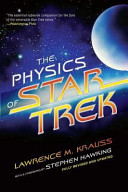The Enterprise's Impulse Drive
Moving back to the sub-light-speed world: We are not through with Einstein yet. His famous relation between mass and energy, E=mc 2 , which is a consequence of special relativity, presents a further challenge to space travel at impulse speeds. As I have described it in chapter 1, a rocket is a device that propels material backward in order to move forward. As you might imagine, the faster the material is propelled backward, the larger will be the forward impulse the rocket will receive. Material cannot be propelled backward any faster than the speed of light. Even propelling it at light speed is not so easy: the only way to get propellant moving backward at light speed is to make the fuel out of matter and antimatter, which (as I describe in a later chapter) can completely annihilate to produce pure radiation moving at the speed of light.
However, while the warp drive aboard the Enterprise uses such fuel, the impulse drive does not. It is powered instead by nuclear fusionthe same nuclear reaction that powers the Sun by turning hydrogen into helium. In fusion reactions, about 1 percent of the available mass is converted into energy. With this much available energy, the helium atoms that are produced can come streaming out the back of the rocket at about an eighth of the speed of light. Using this exhaust velocity for the propellant, we then can calculate the amount of fuel the Enterprise needs in order to accelerate to, say, half the speed of light. The calculation is not difficult, but I will just give the answer here. It may surprise you. Each time the Enterprise accelerates to half the speed of light, it must burn 81 TIMES ITS ENTIRE MASS in hydrogen fuel. Given that a Galaxy Class starship such as Picard's Enterprise-D would weigh in excess of 4 million metric tons, 3 this means that over 300 million metric tons of fuel would need to be used each time the impulse drive is used to accelerate the ship to half light speed! If one used a matter-antimatter propulsion system for the impulse drive, things would be a little better. In this case, one would have to burn merely twice the entire mass of the Enterprise in fuel for each such acceleration.
Notes:
The ship uses hydrogen fusion to propel helium atoms at near the speed of light, but this hypothetical form of propulsion would require incredible amounts of hydrogen to work.
Folksonomies: physics science fiction star trek space travel fusion
Taxonomies:
/science/physics (0.495111)
/business and industrial/aerospace and defense/space technology (0.376826)
/technology and computing (0.259316)
Keywords:
impulse drive (0.971981 (negative:-0.394686)), helium atoms (0.852529 (neutral:0.000000)), light speed (0.818004 (negative:-0.256461)), entire mass (0.767550 (neutral:0.000000)), metric tons (0.762267 (neutral:0.000000)), Galaxy Class starship (0.758652 (neutral:0.000000)), impulse speeds (0.724438 (positive:0.409893)), forward impulse (0.717202 (positive:0.323174)), fuel (0.715450 (negative:-0.256461)), material backward (0.691331 (negative:-0.281963)), Enterprise (0.689576 (neutral:0.000000)), hypothetical form (0.684904 (negative:-0.366615)), incredible amounts (0.684182 (negative:-0.366615)), sub-light-speed world (0.683999 (positive:0.282431)), hydrogen fusion (0.681844 (neutral:0.000000)), famous relation (0.675547 (neutral:0.000000)), special relativity (0.664667 (positive:0.325500)), matter-antimatter propulsion (0.659277 (neutral:0.000000)), pure radiation (0.652536 (negative:-0.425646)), exhaust velocity (0.650838 (neutral:0.000000)), later chapter (0.648609 (neutral:0.000000)), nuclear reaction (0.647210 (neutral:0.000000)), warp drive (0.646893 (neutral:0.000000)), fusion reactions (0.645245 (positive:0.262081)), hydrogen fuel (0.644858 (neutral:0.000000)), available mass (0.636435 (neutral:0.000000)), available energy (0.635729 (positive:0.311525)), rocket (0.608053 (positive:0.041211)), time (0.552409 (neutral:0.000000)), propellant (0.543501 (neutral:0.000000))
Entities:
hydrogen fuel:FieldTerminology (0.789031 (negative:-0.256461)), Einstein:Person (0.301952 (negative:-0.273964)), Picard:Person (0.272181 (neutral:0.000000)), 300 million metric tons:Quantity (0.272181 (neutral:0.000000)), 4 million metric tons:Quantity (0.272181 (neutral:0.000000)), 1 percent:Quantity (0.272181 (neutral:0.000000))
Concepts:
Nuclear fusion (0.969611): dbpedia | freebase
General relativity (0.741114): dbpedia | freebase | opencyc
Helium (0.712947): dbpedia | freebase | opencyc
Mass (0.686917): dbpedia | freebase | opencyc
Special relativity (0.674891): dbpedia | freebase | opencyc
Spacecraft propulsion (0.655897): dbpedia | freebase | yago
USS Enterprise (0.627388): dbpedia | freebase | yago
Velocity (0.625844): dbpedia | freebase





